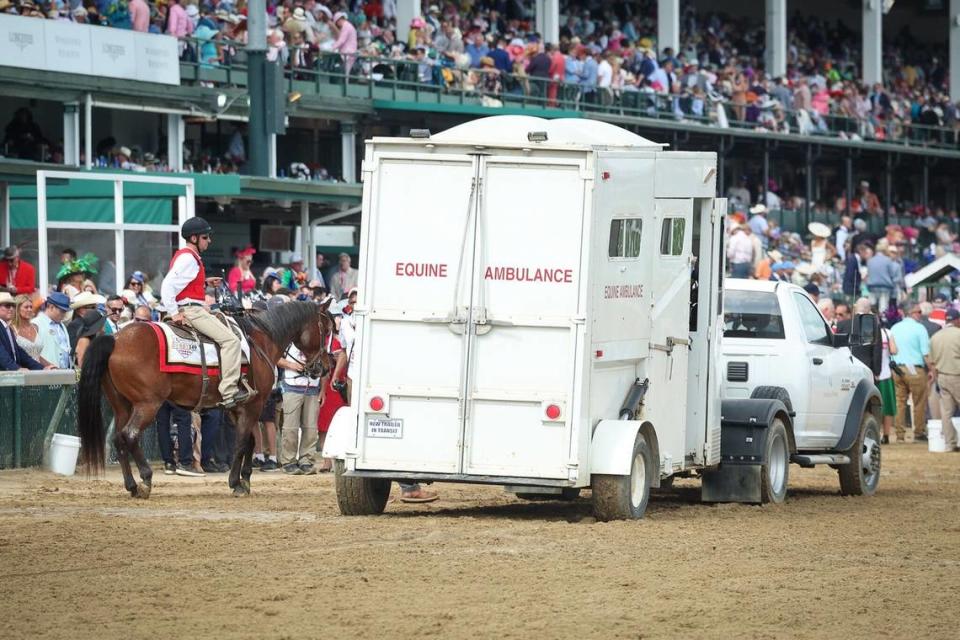After last year’s problems, HISA and Churchill Downs take measures to avoid a repeat
Exactly one year ago, Churchill Downs was a race track in crisis at the worst possible time.
Kentucky Derby week was being overshadowed by an early spate of equine deaths at the Louisville facility. Before the Spring Meet had concluded, the fatalities had risen to 12 and racing had been shifted to the Churchill Downs Inc.-owned Ellis Park in Henderson.
So what’s changed for Kentucky Derby 150?
An investigation conducted by the Horseracing Integrity and Safety Authority (HISA) failed to find a singular cause for the Churchill Downs problems, but HISA and the track have worked together to make changes for the 2024 race and meet.
“When we say there is not one singular factor that caused the breakdowns, it doesn’t mean that we don’t know what the risk factors are that contribute to breakdowns,” HISA CEO Lisa Lazarus said in a Zoom call with media members last week.
Start with the track surface. Trainers and jockeys insisted last year there was nothing wrong with the racing surface, but Churchill Downs has altered the makeup of the track itself, including bringing in 2,000 tons of specialized dirt. It also upgraded maintenance equipment, added turf expert Leif Dickinson to the track operations team and is using University of Kentucky race surface researcher Mick Peterson to conduct analysis and testing.
“The surface was good last year, but it’s even better this year,” said Ann McGovern, HISA’s racetrack safety director, on that Zoom call.
“You can tell the surface is different,” trainer Todd Pletcher said after Florida Derby winner and probable favorite Fierceness worked last Friday. “It’s a different color. It’s got a little different texture to it, different depth to it. We’ve only been here a sport period of time, going through our first set of breezes, but it appears to be in good condition.”
Chad Brown, trainer of Blue Grass Stakes winner Sierra Leone, the second choice in the Derby morning line, agreed.
“I have. I quite like it,” Brown said when asked if he noticed a difference in the track. “You see the color, it seems like it has a little bit more clay in it, which I think is a good thing. My preference is to race and train on tracks that have a little bit more clay on them, whether it be on the top or the base of the track. I think it’s more forgiving, has a little more bounce to it. I’ve been pretty pleased with what I’ve seen here at Churchill so far with the track.”
Pletcher was involved in last year’s major story off the track that came on the morning of the Kentucky Derby when favorite Forte, trained by Pletcher, was scratched after an inspection by the state veterinarian.

This year, working with HISA guidelines, Churchill Downs required Kentucky Derby horses to be on the grounds sooner. The post position draw was also moved up to Saturday, one week before the race. That allows more time for state and track veterinarians to conduct pre-race inspections. Dr. Dana Stead has been added to Churchill’s veterinary team led by Dr. Will Farmer.
Churchill Downs said it has invested in new technology to “help identify horses that may pose an increased risk potential.” All starters will wear StrideSAFE biometric sensor technology to detect changes in a horse’s gait. Churchill has also partnered with Hagyard Equine Medical Institute on a PET machine that is permanently located at the track.
It’s all part of an effort to change the narrative since Santa Anita Park saw 43 equine fatalities in 2019, followed by Churchill Downs’ suspension of trainer Bob Baffert in 2021, the 2022 felony convictions of trainers Jason Servis and Jorge Navarro for doping, and last year’s problems at Churchill Downs.
“I think everyone in the industry is trying to do everything they possibly can to continue to improve the safety,” Pletcher said. “It looks like Churchill has made some significant changes to the surface, and a big component of that is safety. It’s on everyone’s minds. It’s everyone’s responsibility to step up and take the initiative to continue to improve. I think we’re seeing that from all areas of the industry.”
Said Lazarus, “We’re in a much better place today than we were six, seven, eight months ago.”
After last year’s heartbreak, Mike Repole is back in same spot for Kentucky Derby 150
Despite problematic post positions, this Kentucky Derby could be a two-horse race
Post positions drawn for Kentucky Derby and Kentucky Oaks. See the full fields with odds.
Six women jockeys have ridden in the Kentucky Derby. She wants to be the seventh.
At 150 years, the Kentucky Derby is older than ... almost everything. Its place in history.

